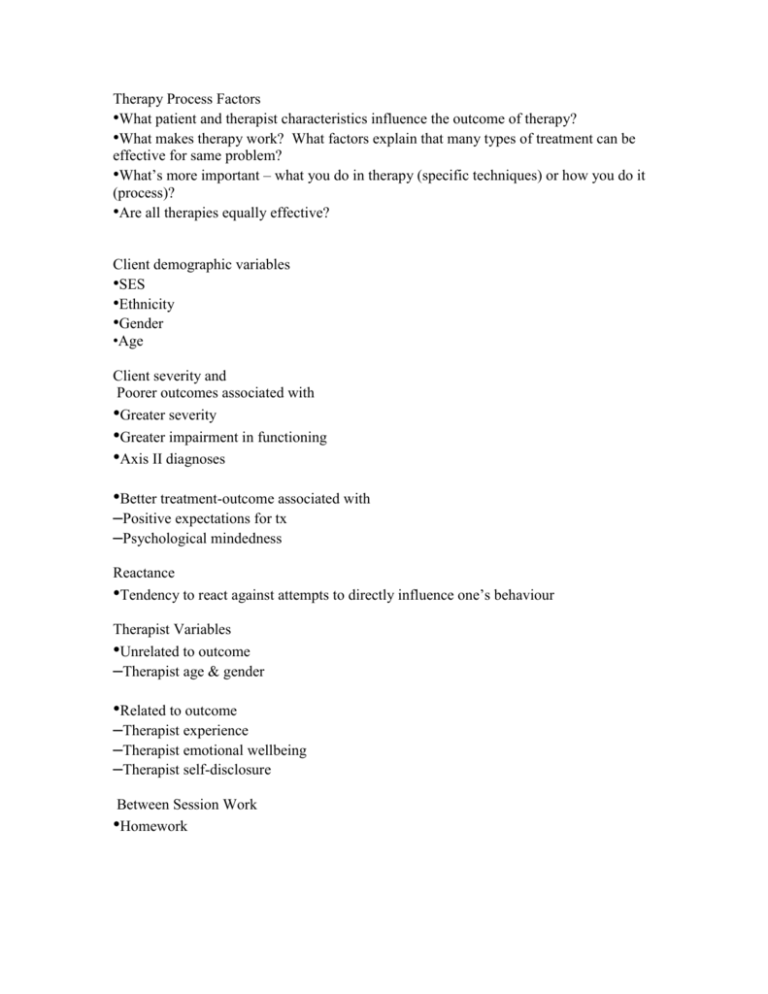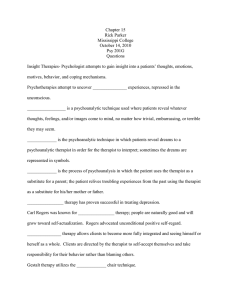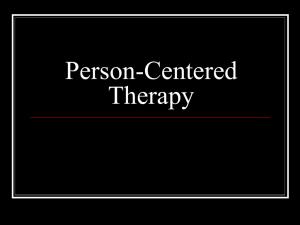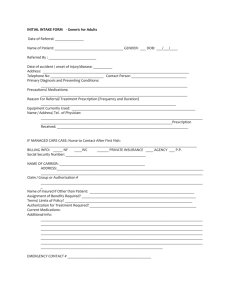Therapy Process Factors
advertisement

Therapy Process Factors •What patient and therapist characteristics influence the outcome of therapy? •What makes therapy work? What factors explain that many types of treatment can be effective for same problem? •What’s more important – what you do in therapy (specific techniques) or how you do it (process)? •Are all therapies equally effective? Client demographic variables •SES •Ethnicity •Gender •Age Client severity and Poorer outcomes associated with •Greater severity •Greater impairment in functioning •Axis II diagnoses •Better treatment-outcome associated with –Positive expectations for tx –Psychological mindedness Reactance •Tendency to react against attempts to directly influence one’s behaviour Therapist Variables •Unrelated to outcome –Therapist age & gender •Related to outcome –Therapist experience –Therapist emotional wellbeing –Therapist self-disclosure Between Session Work •Homework Common Factors •Rosenzweig’s beliefs (1936) •Jerome Frank (1970’s) •Weinberger Therapeutic Alliance Support for Therapy Equivalence •Luborsky et al (1975-2002) •Wampold (1997) Evidence against Therapy Equivalence •Smith, Glass, Miller (1980) meta-analysis •Child/adolescent treatment literature Empirically supported therapy relationships (ESRs) •Include evidence from experimental and correlational studies of adults •Categorize as –Demonstrably effective –Promising and probably effective –Insufficient research to judge Integration in Practice •Integrate empirically supported treatments (specific techniques) with elements of empirically supported relationships (alliance, empathy, goal consensus). Exposure Therapy for Anxiety: A behavioural approach •Origins of behaviour therapy •Application of exposure therapy to –Specific phobias –Obsessive compulsive disorder (OCD) •Conditioning models –Pavlov - classical conditioning –Skinner - operant conditioning •Human Applications -Watson -Systematic desensitization Specific Phobia •Animals •Natural environment •Situational •Blood-injection-injury •Other Facts: Specific Phobias •Prevalence: 4-8% •First symptoms usually occur in childhood •How develop –Traumatic events –Observation of others in traumatic situation or exhibiting anxiety –Information transfer •How maintained over time? --Avoidance Exposure as alternative Guiding Rules of Exposure • Exposure tasks must provoke anxiety • Prolonged • Repeated as often as possible • No avoidance/escape • Gradual Creation of a hierarchy DVD: Hierarchy Building •Note factors that influence clients fear level OCD Facts •Lifetime prevalence 2-3% •Chronic wax and wane course •In adults, equally common in men and women –Age onset earlier males (childhood) vs. females (20’s) Exposure and Response Prevention for OCD •In vivo Exposure •Imaginal Exposure: •Ritual Prevention: Video: Exposure for OCD •What see therapist doing to assist client in exposure?











